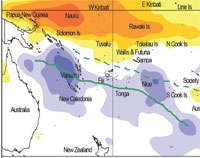
Climate assessment of the 2007–08 rainy season in New Caledonia
Luc Maitrepierre, Head of Climate Division, Météo-France, New Caledonia
Climate of New Caledonia
In New Caledonia, the rainy season normally occurs between December and April. Like many countries in the western Pacific, the New Caledonia archipelago is under the influence of the Inter Tropical Convergence Zone (ITCZ), and the SPCZ (South Pacific Convergence Zone) during the summer. New Caledonia is subjected to precipitation patterns from both of the convergence zones and instabilities from moist tropical air masses. In addition, New Caledonia is in the western South Pacific basin, where tropical cyclones are active, and often impact the country with heavy rains and high winds. The rain during December – April amounts to 55% to 65% of the annual total, with January – March rainfall representing 40% to 50% of the annual total.
An unusual year
It is important to note that New Caledonia was not directly affected by any tropical cyclone during the past summer, and this makes the high precipitation totals during the 2007–08 rainfall season even more a typical. The deluge over New Caledonia this past year can mainly be explained by the La Niña event that existed in the tropical Pacific Ocean this summer. This event included an ITCZ situated further south than usual during February and March (Figure 1), and a very unusual position of the SPCZ, which was displaced very far to the south and west of it’s normal location in March.
2007–08- A season of records
For the 2007–08 rainy season, the monthly mean precipitation departure from normal was +57% in December, +9% in January, +79% in February, +120% in March and +195% in April, calculated from 28 reference stations. Based on the 1951- 2008 reference period, April 2008 is ranked the second wettest April, while March 2008 marked a new record high, surpassing the old record from 1967 of +117% of normal rainfall. The last three months of the 2007–08 rainy season between February and April had a three month mean precipitation departure of +121% of normal, making it the wettest February – April since 1951. The December – April assessment shows a five–month mean departure from normal of +86%, which is a new record slightly above the oldest value of +85% in the 1988–89 season. Extreme rainfall values for December – April rainfall (right) indicate many stations received more rain in five months than they usually do in one year:
- 1282 mm at Koumac, 31% above the annual mean total.
- 2910 mm at Canala, 73% above the annual mean total.
- 3384 mm at Ponérihouen, 26% above the annual mean total.
- 3541 mm at Yaté-Usine, 10% above the annual mean total.
- 1668 mm at Ouanaham, 2% below the annual mean total.
- 893 mm at Nouméa, 16% below the annual mean total.
Rainy season impacts
Agriculture was greatly impacted by abundant rainfall during the 2007–08 rainy season. Moisture and diseases caused by excessive rainfall destroyed tomatoes and lettuce crops. Planting schemes also had to be significantly delayed because the soil was too wet. In addition, roads were severely damaged and many construction industry projects were delayed. The mining industry was also impacted at one location where a large landslide, triggered by high rainfall, terminated in a lagoon resulting in sedimentation and natural habitat destruction. A protest by local ecologists following this event has led to mitigation projects aimed at limiting the environmental impact of mining. One of the more serious outcomes of high rainfall anomalies during the late part of the 2007–08 rainy season was an outbreak of dengue fever, with more than 600 people affected by the disease from January to April. The most recent assessment shows that the epidemic is not finished yet, as more than 250 new cases have been reported since the beginning of May.
